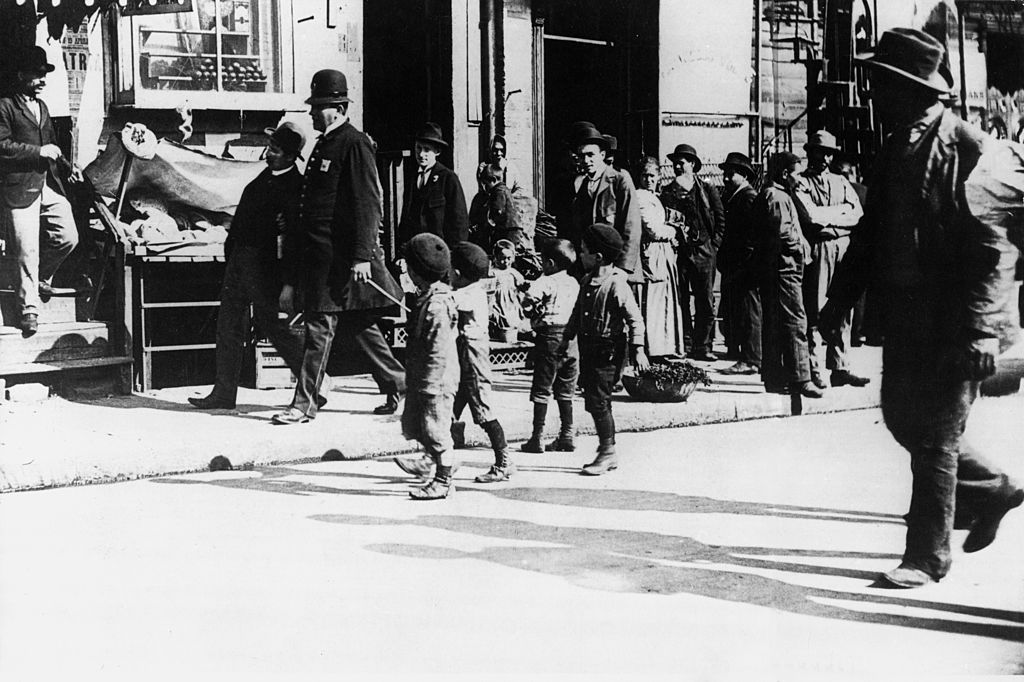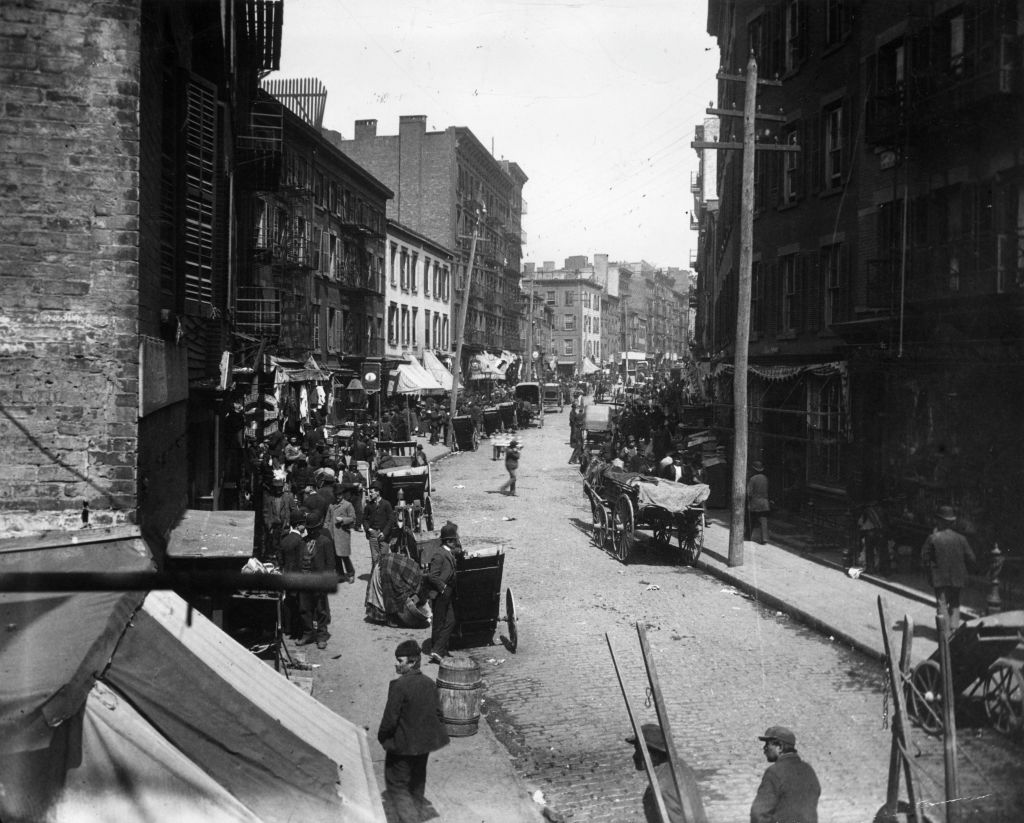
On the campaign trail, former President Donald Trump has vowed to carry out the “largest deportation operation” in U.S. history, including going after people based on their political ideologies. While such statements are extreme, there are historical precedents for the mass deportation of political dissidents and the technology is already in place, should Trump retake the presidency and attempt to try. Over the last century the United States has built a painstaking system of surveillance that would help make Trump’s plans reality. From files and filing cabinets to ankle monitors and cell phone application location tracking, the government has built a massive regime for attempting to know who and where everyone is—with especially stark consequences for non-citizens.
This approach of monitoring and collecting information about immigrants is rooted in changes in policing and surveillance technology that came together at the end of the 19th century. Then, authorities sought to counteract what many in government called the “colonies” of immigrants, enclaves where English was far from the most commonly used language.
In places like Mulberry Bend in Manhattan’s Lower East Side, police sought to control the landscape and those who lived in it. In 1895, the city demolished the entire block and turned it into a wide-open park where it was nearly impossible to hide from law enforcement. It was a show of control over a population made up largely of new immigrants from Italy, Eastern Europe, and East Asia who were deemed as opaque and unknowable as the dense tangle of alleyways that made up the Bend.
Read More: America’s High-Tech Surveillance Could Track Abortion-Seekers, Too, Activists Warn
Police continually looked for other ways to marginalize, brutalize, and control these communities by citing concerns that crime, political radicalism, and norm-defying sexualities could flourish in communities and spaces unknowable to police. Police used both surveillance and violence to discipline white immigrant communities, to push them to act "American." As NYPD Commissioner for the year 1904, William McAdoo, wrote, police do “far more important work, so far as the future citizens are concerned, than probably any other officials in this land.”
And so, the NYPD experimented with ways to subordinate immigrant communities in the first two decades of the 20th century. They created squads and staffed them with people who had been born speaking foreign languages and deployed them into their own communities as informants and spies. But in the end, the department found this approach unreliable and unsustainable.
Soon a solution came from technology used abroad. In the 1910s Raymond Fosdick, a former New York City police administrator, traveled the world on the Rockefeller family’s dime to study the problems of American policing. He concluded that the advanced and prolific European system of information collection and management was the future of policing. He brought back to the United States stories of how the Berlin police department had records on potentially hundreds of thousands of individuals which he believed greatly increased the ability of German police to find and identify people based on a whole suite of information like address, family history, criminal history, military records, and so on. If a fire had been set in a certain neighborhood, with barely any detective work on the street, police could cross reference the area with people with a history of arson and create a list of likely suspects. Technologies made talking to witnesses or interfacing with community members less necessary for solving crimes.

Such techniques of surveillance had real appeal to police in the U.S. They were grappling with low levels of trust for the police in immigrant neighborhoods. And these ideas appealed amid a rising tide of social sciences with their emphasis on statistical analysis, medical expertise, and methodical attempts to find the “root” causes of social problems.
The London police offered another solution: fingerprinting. The British forces had pioneered the use of this technology in its own overseas colonies in which the culture and language differed between the police and the policed. The surveillance tool fascinated American reporters who marveled at how the technology might revolutionize detective work. “It is not necessary,” read one Kansas newspaper “to know a man’s age, color, or any circumstance of his life in order to discover his personality by means of the finger-print method.”
Read More: New York Bans Facial Recognition in Schools
Fingerprinting’s ability to identify a person without police having to speak or understand that person was part of its appeal, particularly in cities and neighborhoods with large numbers of immigrants. A data-fied approach to surveillance promised to flatten city blocks as effectively as demolition, at least in the eyes of police. If a person’s fingerprint had been found at crime scene, and police could connect that print to a file, it didn’t matter what language that person spoke or how foreign their culture seemed to police.
By the 1920s, such surveillance technology had become part of the emerging federal immigration enforcement apparatus. The retention of criminal files on individuals in other countries became a lauded resource for sparking deportation proceedings. Over the next decade, authorities sought criminal files in other countries in order to justify deportations of European as well as Mexican immigrants.

Since then, police departments and federal agencies worked together in their efforts to embrace surveillance and technology as key tools to control communities. As early as the 1950s, security cameras became a way of live monitoring multiple locations at once in a way that did not require a watcher to be physically on the ground. And this approach to policing has had consequences for immigrants, especially over the last two decades as immigration enforcement has ramped up and frequently entailed coordination with local police. The state of California has only just stopped sharing data from devices which track the movement of vehicles with out-of-state agencies, which has concerned immigrants’ rights advocates for some time.
Of course, this surveillance-dependent style of policing has consequences for all residents in a community, as we can see in stories about police contacting Amazon for footage from Ring surveillance doorbell cameras, in cell phone surveillance, or high-powered audio devices which supposedly hear gunshots and summon police without any public involvement. They are building upon a regime of policing that wants to remove human interaction and replace it with something with less variables—something totalizing, standardized, and built on a spirit of distrust and animosity.
It is no accident that this approach is rooted in urban policing from a century ago, when police were eager to find ways to control communities that were majority immigrant, and which they found socially and culturally unruly. They undertook that work without community consent or participation. And that history makes plain that control, not safety, was the real aim.
Matthew Guariglia is a historian of race, ethnicity, policing, and technology. His book, Police and the Empire City: Race and the Origins of Modern Policing in New York is out now from Duke University Press. Made by History takes readers beyond the headlines with articles written and edited by professional historians. Learn more about Made by History at TIME here.
More Must-Reads from TIME
- How Donald Trump Won
- The Best Inventions of 2024
- Why Sleep Is the Key to Living Longer
- Robert Zemeckis Just Wants to Move You
- How to Break 8 Toxic Communication Habits
- Nicola Coughlan Bet on Herself—And Won
- Why Vinegar Is So Good for You
- Meet TIME's Newest Class of Next Generation Leaders
Write to Matthew Guariglia / Made by History at madebyhistory@time.com
